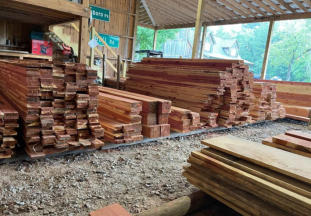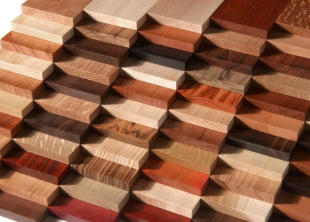The Wood Makes It Good
Wood species matters
White Pine. The price of wood has gone up consideably in the past few years. SPF (spruce, pine, or fir), the industry soft wood standard, is easy to work with but is the least durable wood to use for bee equipment. If the finish is not properly applied and maintained, then the wood begins to split and rot in a matter of years. If nails are left exposed, they will start to rust and discolor the surrounding wood, leading first to mold, then rot. Premium Pine, or radiata pine, now available in home centers, has a beautiful grain, but is unstable. It will cup, warp and twist quickly in humidity and temperature variations, and makes trueing the size and flatness of components difficult. Southern Yellow Pine , is readily available and is a common and sturdy construction material, but it does not work well with fine detail. It is very heavy wood, and has large grain that leads to checks and splits. Treated lumber is made from yellow pine. Cyprus has been an regular upgrade for stock wooden ware at many bee supply houses. It is naturally rot resistant, durable and lightweight. It holds up well to any paint finish and has a beautiful grain pattern when left natural. Unfortunately cyprus can be more difficult to acquire. Western Red Cedar, or Eastern White Cedar. Most cedar siding, interior paneling and appearance boards found in lumber yards are one of these types of cedar. It is a soft and lightweight wood and is naturally rot resistant. The softness of the wood make it easy to mill but less durable in constructing bee components which need strong corner joints. Eastern Juniper. This wood is similar to cyprus and has beautiful straight grain and is very durable when used outdoors. It tends to be more expensive out of the naturally rot resitant woods and can be more difficult to find. Eastern Red Cedar is a species we have recently started using. It has the beautiful natural red and white color variations you see in some of the photos on this page and the finished hive on the first page. Red cedar is used for fence posts on farms because it is readily available in many areas and is rot resistant, even in ground contact. With a good finish, this durable wood should last indefinately. Other Hardwoods. Almost any stable hard wood species would make a good choice for building bee hive components. Woods like oak, walnut, cherry or pecan would work well if finished properly. The drawbacks of these woods are availability in the sizes needed, the costs, and their weight. We would welcome the opportuntity to use any appropriate wood to help further customize your hive.
What do you want in your back yard?






























































